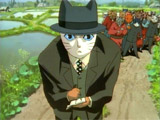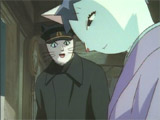

Quick Links:
Spring and Chaos
The first thing you’ll notice when you watch Spring and Chaos is that every one of the characters is an anthropomorphic cat or dog. The second thing you’ll notice is that the movie (which is what I’m calling it, although it only clocks in at 57 minutes, credits included) makes no freakin’ sense. I’ll leave it to you to decide which one of those factors is more detrimental to the anime’s quality. As for myself, I’m not sure. I liked Sherlock Holmes, and that was nothing but dogs wearing trench coats and smoking pipes; and I liked Serial Experiments Lain, which made about as much sense as a drunken Roberto Benigni. And yet, I didn’t like Spring and Chaos. Hmm, interesting....
The movie is very, very loosely based on the life of the famous Japanese poet, Kenji Miyazawa, who is world-renowned for his entirely metaphorical and slightly incoherent poems which pierce deeply into the reader’s connection with the earth. However, instead of a straight biographical feature, the writers decided to set the script in the stylings of Miyazawa’s poetry, and thus abstract images, left-field quotations, and nature-related themes abound. Unfortunately, the writers possess severely inferior skill when compared to the master poet, and thus all the afore-mentioned artsy qualities are presented in a ham-fisted and pretentious manner. Only a few of the references to Miyazawa’s poems are well placed, the best being the "telegraph lines" mentioned at the very beginning, and the worst being the unnecessary appearance from the train on the Galactic Railroad. (If that name sounds familiar, it should. Night on the Galactic Railroad is excellent anime that uses Kenji’s poems wisely and to their fullest advantage. Go rent it now!)
What truly makes the movie’s misguided usage of symbolism even more unfortunate is that deep underneath an actually good story is there, just waiting to be written. Miyazawa led an interesting life of constant rejection and an ultimately failed search for acceptance. The more coherent scenes of his early life as a amateur and his later years as a teacher make for the best parts of the movie, and give brief, interesting examples of how he gained the insight we all remember him for so many years after the fact. Too many times these scenes are skipped in favor of trendy music video-esque seques that try so hard to be brilliant and thoughtful but come off as inexperienced and poorly made. The actual story scenes are the reasons I’m giving this movie a B-, and they’re why you should watch it.
On the presentation side of things, Spring and Chaos earns the distinct honor(?) of being Tokyopop’s first foray into anime. Thankfully, being a movie, it did not suffer from the OP/ED editing that early TV series like Vampire Princess Miyu and Fancy La La faced in their earlier volumes. On the whole, the packaging here is nicely done, giving the buyer a decent idea of the rather untraditional style inside. Oddly, they used a relatively normal shot of the students for the disk itself, which kind of ruined the mood for me. The extras are all the old favorites and nothing more - interviews, trailers, and art gallery - which is fitting considering this being TP’s maiden voyage. It was kind of sad watching the interview with director/writer Shoji Kawamori (a.k.a. Anime Demigod), because the man clearly has total adoration for Miyazawa’s works, and I just don’t think he did the poet justice.
The visuals in the movie are all over the place, but that’s intentional. The more traditional scenes use nicely drawn designs somewhat reminiscent of Studio Ghibli’s works. However, some of the more fantastical pieces greatly overuse the CGI, which, while not being choppy as most, still doesn’t fit well with the traditional animation. The director also seems fond of keeping the camera in constant motion, and thus creating a sweeping effect even while the characters themselves are stagnant. While being distracting, I did actually think was a nice effect.
Much in the style of Kenji Miyazawa’s own poetry, Spring and Chaos throws away all sense of plot, development, and rhythm in favor of pure metaphor. Not in the style of the Miyazawa’s brilliant prose, however, is that Spring and Chaos can’t quite seem to figure out how exactly to get that metaphor across to the viewer. It obviously wants to use the famous poet’s life as a symbol for something, but along the way it gets so wrapped up in its shallow pseudo-intellectual philosophizing and psychedelic cut-scenes that in the end it finally just chucks any sense of depth or meaning out the window. And that is a shame, really, because using a writers’ own works to symbolize their life is a great concept. You just have to do it right.
Distributor: TOKYOPOP Creator: Group TAC Released: 1996
Plot: C Character Design: B Animation Quality: B+ Music: B+ Overall: B-



